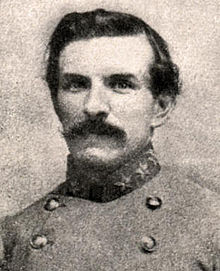James Conner (general)
| James Conner | |
|---|---|
 |
|
| Born |
September 1, 1829 Charleston, South Carolina |
| Died | June 26, 1883 (aged 53) Richmond, Virginia |
| Buried at | Magnolia Cemetery (Charleston, South Carolina) |
| Allegiance |
|
| Service/branch |
|
| Years of service | 1861–1865 (CSA) |
| Rank |
|
| Unit |
Brigade, Army of Northern Virginia |
| Battles/wars |
|
| Other work | Lawyer, Attorney General of South Carolina |
James Conner (September 1, 1829 – June 26, 1883), was a Confederate States Army brigadier-general during the American Civil War. He was a lawyer in South Carolina both before and after the war and was elected Attorney General of South Carolina in 1876.
James Conner was born on September 1, 1829 in Charleston, South Carolina. After graduating from that state's College in 1849, he studied law and practiced it in Charleston. In 1856, he was appointed United States district attorney and served in this office until 1860. Conner authored The History of a Suit at Law (1857). He prosecuted the famous case against the slave ship Echo. He also prosecuted a member of William Walker's filibustering effort. Conner was a secessionist and supported the calling of a secessionist convention. Although he was a member of the convention, he did not vote on the ordinance of secession.
James Conner participated in the bombardment of Fort Sumter as a captain of the Montgomery Guards, a South Carolina militia unit. At the beginning of the Civil War, he declined an appointment as a district attorney for the Confederacy. Instead, he became a captain in the Hampton Legion and fought at the Battle of First Bull Run (First Manassas), taking temporary command of the legion after Colonel Wade Hampton was wounded. On July 21, 1861, Conner was appointed major of Hampton's Legion. After the Battle of Seven Pines during the Peninsula Campaign, he took command of the 22nd North Carolina Volunteer Infantry Regiment. During the Seven Days Battles, his leg was broken by a rifle ball during the Battle of Gaines Mill. After a two-month recovery period, he returned to lead his regiment at the Battle of Chancellorsville and the Battle of Gettysburg.
...
Wikipedia
